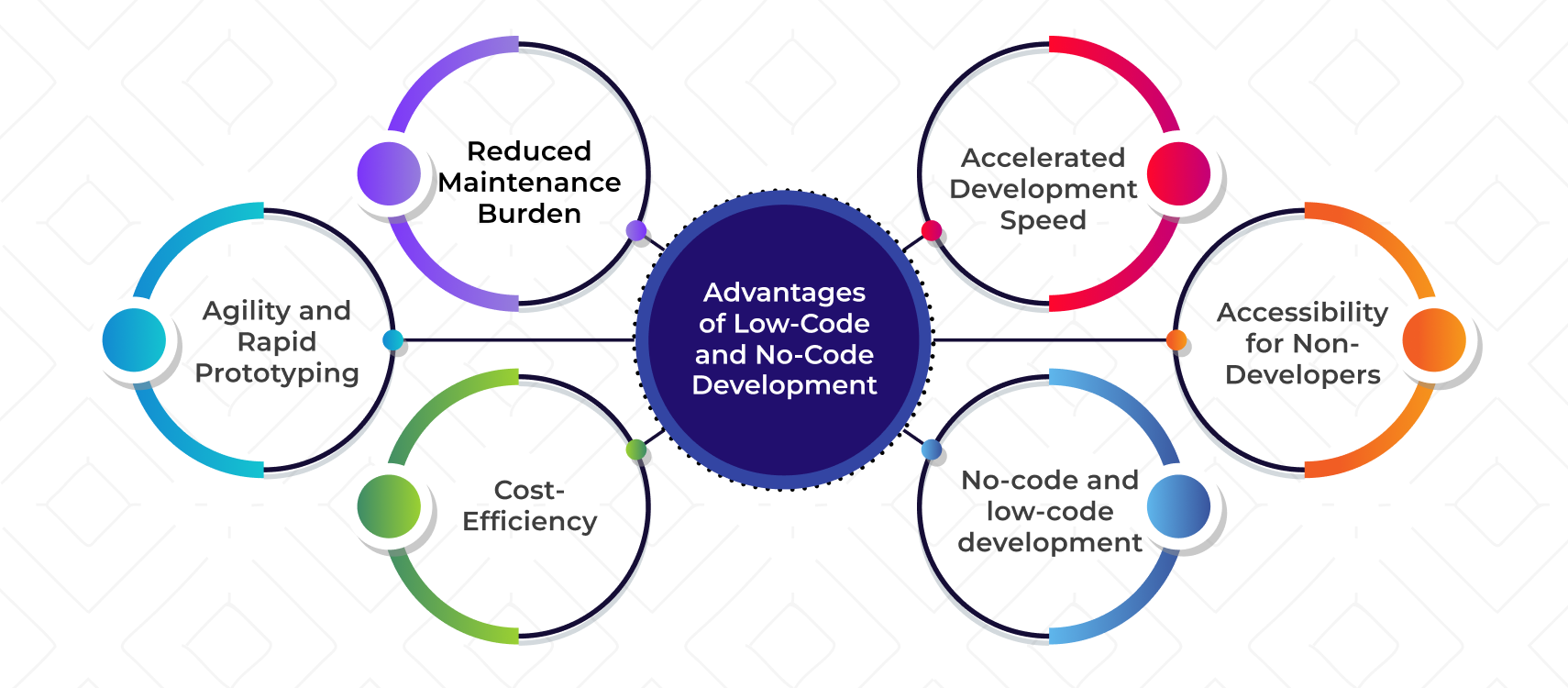Table of Contents
- Advantages
- Shortcomings
- Use Cases
- Most Popular Platforms
- Ending Notes
The landscape of software development has witnessed a transformative shift with the rise of low-code and no-code platforms. These innovative approaches empower individuals with varying technical backgrounds to create applications without the need for extensive coding expertise. More importantly, without hiring expert app development services, a non-developer business owner can build an effective app using a no-code platform. This paradigm shift has ignited discussions about the advantages, shortcomings, and diverse use cases of low-code and no-code development.
In this comprehensive article, we will explore advantages, shortcomings, use cases and popular platforms pertaining to no-code and low-code development approaches.
Advantages of Low-Code and No-Code Development

Accelerated Development Speed
One of the most prominent advantages of low-code and no-code development platforms is the significant reduction in development time. Traditional coding demands substantial time and effort, from writing lines of code to debugging and testing. With low-code and no-code platforms, much of this time-consuming process is replaced with visual interfaces and pre-built components. This acceleration translates into faster time-to-market for applications, enabling businesses to respond swiftly to evolving market demands.
Accessibility for Non-Developers
No-code and low-code development platforms democratize application development by making it accessible to individuals without extensive coding skills. This inclusivity empowers business analysts, subject-matter experts, and citizen developers to actively participate in application creation. By bridging the gap between business needs and technical implementation, these platforms foster collaboration between technical and non-technical teams, resulting in solutions that align closely with business objectives.
Cost-Efficiency
Developing applications from scratch can incur substantial costs, including hiring skilled developers and investing in their training. Low-code and no-code platforms significantly reduce the dependency on specialized technical talent, leading to cost savings. These platforms offer pre-built templates, components, and integrations that minimize the need for custom coding. As a result, businesses can allocate resources more efficiently and invest in other critical areas of growth.
Cost-Efficiency
Developing applications from scratch can incur substantial costs, including hiring skilled developers and investing in their training. Low-code and no-code platforms significantly reduce the dependency on specialized technical talent, leading to cost savings. These platforms offer pre-built templates, components, and integrations that minimize the need for custom coding. As a result, businesses can allocate resources more efficiently and invest in other critical areas of growth.
Agility and Rapid Prototyping
Low-code and no-code platforms enable businesses to iterate quickly and experiment with new ideas. Rapid prototyping becomes feasible, allowing organizations to gather user feedback and make iterative improvements. This agility is particularly valuable when addressing evolving market trends, user preferences, and competitive challenges. Organizations can swiftly adapt their applications to changing requirements, facilitating innovation and responsiveness.
Reduced Maintenance Burden
Traditional software development requires continuous maintenance and updates to keep applications secure and functional. Low-code and no-code platforms often handle security updates and infrastructure maintenance automatically. This frees up resources that would otherwise be allocated to ongoing maintenance, allowing developers to focus on enhancing the application’s functionality and user experience.
Shortcomings of Low-Code and No-Code Development
Limited Customization and Flexibility
While low-code and no-code platforms offer convenience, they may impose limitations on customization and flexibility. Complex and unique business requirements may not be adequately addressed by the predefined components and templates provided by these platforms. Organizations with intricate workflows or specific functionality needs might find themselves constrained by the platform’s limitations.
Vendor Lock-In
Adopting a specific low-code or no-code platform can lead to vendor lock-in, where organizations become reliant on the platform’s proprietary tools and infrastructure. This lock-in can limit future migration or integration options, inhibiting the organization’s ability to adapt to changing technology trends or business needs.
Scalability Concerns
As applications built on low-code and no-code platforms grow in complexity and user base, scalability concerns can arise. These platforms might not offer the same level of scalability as custom-coded solutions, potentially leading to performance bottlenecks or limitations in accommodating increasing demand.
Lack of Advanced Functionality
Low-code and no-code platforms are designed to simplify the development process, but they might not support advanced or specialized functionalities required by certain industries. Applications with complex logic, intricate algorithms, or integration with specialized hardware might face challenges in implementation using these platforms.
Security and Compliance Risks
Pre-built components and templates offered by low-code and no-code platforms can introduce security vulnerabilities if not used correctly. Organizations must ensure that the applications developed through these platforms adhere to security best practices and comply with industry regulations.
Use Cases for Low-Code and No-Code Platforms
Rapid Prototyping and Proof of Concepts
Low-code and no-code platforms are ideal for quickly prototyping ideas and concepts. Businesses can create functional prototypes to showcase potential features to stakeholders, gather feedback, and make informed decisions before investing in full-scale development.
Internal Process Automation
Organizations can leverage these platforms to automate internal processes, such as employee onboarding, leave requests, and approval workflows. Non-technical teams can design workflows that improve efficiency and reduce manual tasks.
Mobile App Development
Creating mobile applications is often resource-intensive, requiring expertise in various programming languages. Low-code and no-code platforms simplify mobile app development, allowing businesses to reach customers on their preferred devices without extensive coding.
Customer-Facing Applications
Companies can use these platforms to develop customer-facing applications such as self-service portals, reservation systems, and e-commerce platforms. These applications enhance customer experiences and enable businesses to interact more effectively with their clientele.
Data Visualization and Dashboards
Creating interactive data visualizations and dashboards can be challenging for non-technical users. Low-code and no-code platforms enable organizations to transform complex data sets into insightful visual representations without writing code.
Most Popular Low-Code and No-Code Platforms
- Microsoft Power Apps: Part of the Microsoft Power Platform, Power Apps enables users to create custom apps and workflows using a visual interface. It integrates seamlessly with other Microsoft tools and offers a range of pre-built connectors.
- OutSystems: OutSystems provides a comprehensive low-code platform that supports end-to-end application development. It focuses on speed, scalability, and a unified development environment.
- Appian: Appian offers a low-code automation platform that enables businesses to automate complex processes and develop applications rapidly. It emphasizes process automation and offers a wide range of integrations.
- Mendix: Mendix is known for its user-friendly interface and strong collaboration features. It allows users to build web and mobile applications with ease, focusing on both developers and non-developers.
- Bubble: Bubble is a no-code platform that empowers users to create web applications visually. It emphasizes simplicity and offers the flexibility to create custom solutions without writing code.
Ending Notes
The emergence of low-code and no-code platforms marks a significant evolution in the software development landscape. These platforms offer unparalleled speed, accessibility, and cost-efficiency, enabling organizations to innovate and create applications tailored to their specific needs. They are also playing an instrumental role in bridging the gap between technical and non-technical users.










